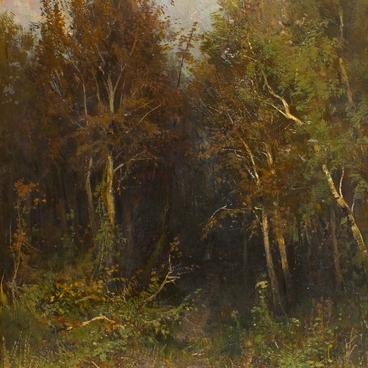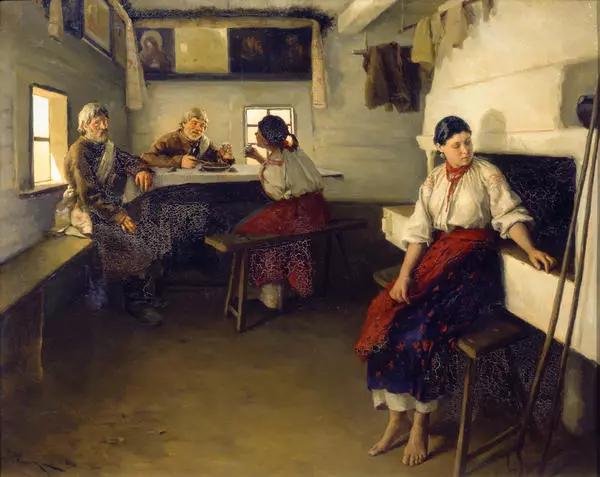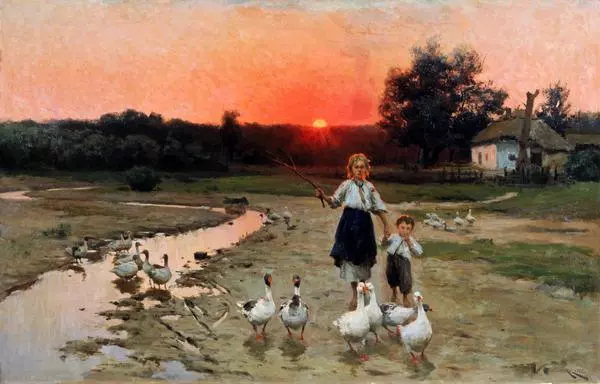The life of peasants became the main subject of artworks of a Russian artist Nikolai Pimonenko. In his artworks he showed the nature and culture of Ukraine.
The future artist was born in the family of an icon-painter in the Kiev suburb called Priorsk.
At the age of 18, he entered the Kiev painting school named after N.I. Murashko, and two years later he was enrolled to the Imperial Academy of Arts. Nikolai Pimonenko was considered a talented student: at the Academy, he was awarded two small and one large silver medals ‘For good results’.
After returning to his homeland, Pimonenko became a teacher at the Kiev painting school and later initiated the establishment of the Kiev Art School. His artworks were presented at international exhibitions in London, Munich, Berlin and Paris. In 1891, his artwork ‘Gopak’ was awarded the golden medal of the Salon de Paris of the Society of French artists, and then it was included in the Louvre collection. For many years Nikolay Pimonenko was a member of the traveling exhibitions association.
In the late 1880s, the main theme of Pimonenko’s artworks was the life of the Ukrainian village. In the painting “Christmastide fortunetelling”, the author’s version of which is kept at our Museum, Pimonenko sentimentalized the peasant life. Beautiful and smiling girls in this picture are watching with interest and excitement the shadow on the wall whimsically changing its shape. This is a traditional Christmastide entertainment: during the winter holidays, unmarried peasant women gathered in groups and were guessing what the future will be like — when they would get married, who their husbands would be, and what their life would be like. There were a lot of methods for fortunetelling: you could hide behind the window and listen to what the people in the house are saying, and interpret other people’s words, you could throw your shoes out of the gate, put a comb under your pillow, make a tunnel of two mirrors at night and look inside this tunnel, or give a chicken some grain — the first one the chicken comes up to, will be the first one to get married. A simple candle was also used for fortunetelling: girls poured molten wax into the water or watched the shadows play. And then they tried to guess the meaning of the figures they saw.
The painting “Christmastide fortunetelling” was exhibited at the academic exhibition in 1888. Art critics highly appreciated this picture.
The future artist was born in the family of an icon-painter in the Kiev suburb called Priorsk.
At the age of 18, he entered the Kiev painting school named after N.I. Murashko, and two years later he was enrolled to the Imperial Academy of Arts. Nikolai Pimonenko was considered a talented student: at the Academy, he was awarded two small and one large silver medals ‘For good results’.
After returning to his homeland, Pimonenko became a teacher at the Kiev painting school and later initiated the establishment of the Kiev Art School. His artworks were presented at international exhibitions in London, Munich, Berlin and Paris. In 1891, his artwork ‘Gopak’ was awarded the golden medal of the Salon de Paris of the Society of French artists, and then it was included in the Louvre collection. For many years Nikolay Pimonenko was a member of the traveling exhibitions association.
In the late 1880s, the main theme of Pimonenko’s artworks was the life of the Ukrainian village. In the painting “Christmastide fortunetelling”, the author’s version of which is kept at our Museum, Pimonenko sentimentalized the peasant life. Beautiful and smiling girls in this picture are watching with interest and excitement the shadow on the wall whimsically changing its shape. This is a traditional Christmastide entertainment: during the winter holidays, unmarried peasant women gathered in groups and were guessing what the future will be like — when they would get married, who their husbands would be, and what their life would be like. There were a lot of methods for fortunetelling: you could hide behind the window and listen to what the people in the house are saying, and interpret other people’s words, you could throw your shoes out of the gate, put a comb under your pillow, make a tunnel of two mirrors at night and look inside this tunnel, or give a chicken some grain — the first one the chicken comes up to, will be the first one to get married. A simple candle was also used for fortunetelling: girls poured molten wax into the water or watched the shadows play. And then they tried to guess the meaning of the figures they saw.
The painting “Christmastide fortunetelling” was exhibited at the academic exhibition in 1888. Art critics highly appreciated this picture.







